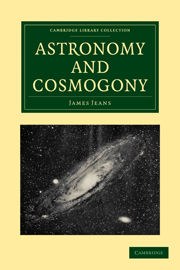Book contents
- Frontmatter
- Contents
- LIST OF ILLUSTRATIONS
- PREFACE
- CHAP. I The Astronomical Survey of the Universe
- CHAP. II The Light from the Stars
- CHAP. III Gaseous Stars
- CHAP. IV The Source of Stellar Energy
- CHAP. V Liquid Stars
- CHAP. VI The Evolution of the Stars
- CHAP. VII Non-spherical Masses–Dynamical Principles
- CHAP. VIII The Configurations of Rotating Liquid Masses
- CHAP. IX The Configurations of Rotating Compressible Masses
- CHAP. X Rotation and Fission of Stars
- CHAP. XI The Evolution of Binary Systems
- CHAP. XII The Ages of the Stars
- CHAP. XIII The Great Nebulae
- CHAP. XIV The Galactic System of Stars
- CHAP. XV Variable Stars
- CHAP. XVI The Solar System
- CHAP. XVII Conclusion
- Index of Subjects
- Index of Names
CHAP. V - Liquid Stars
Published online by Cambridge University Press: 07 September 2010
- Frontmatter
- Contents
- LIST OF ILLUSTRATIONS
- PREFACE
- CHAP. I The Astronomical Survey of the Universe
- CHAP. II The Light from the Stars
- CHAP. III Gaseous Stars
- CHAP. IV The Source of Stellar Energy
- CHAP. V Liquid Stars
- CHAP. VI The Evolution of the Stars
- CHAP. VII Non-spherical Masses–Dynamical Principles
- CHAP. VIII The Configurations of Rotating Liquid Masses
- CHAP. IX The Configurations of Rotating Compressible Masses
- CHAP. X Rotation and Fission of Stars
- CHAP. XI The Evolution of Binary Systems
- CHAP. XII The Ages of the Stars
- CHAP. XIII The Great Nebulae
- CHAP. XIV The Galactic System of Stars
- CHAP. XV Variable Stars
- CHAP. XVI The Solar System
- CHAP. XVII Conclusion
- Index of Subjects
- Index of Names
Summary
THE GENERAL CONDITION OF LIQUID STARS.
In Chapter III we investigated the internal equilibrium of the stars on the supposition that they were masses of gravitating gas, in which the gas-laws were obeyed throughout. The investigation was abandoned when it was found to lead to impossibly high values for the atomic weights of the stellar atoms. This created a suspicion that the hypothesis on which it was based was unfounded, and that the gas-laws are not obeyed in stellar interiors.
The last chapter provided further evidence to the same effect. We there investigated the mode of generation of stellar energy, using the guiding principle that all modes of generation of energy which make the stars dynamically unstable can be ruled out of the list of practical possibilities. We found that when the gas-laws are supposed to be obeyed, no possibilities remain for stars of enormously great mass. Further the only mode of generation of energy which was both physically acceptable and consistent with the stability of actual stars proved to be one in which the rate of generation of energy is uninfluenced by changes of density and temperature, as in radioactive substances, and this, as we shall see at once (§ 134), requires substantial deviations from the gas-laws in stars of all masses.
We now rediscuss the problem of the physical constitution of the stars, and examine the form it assumes when the gas-laws are no longer obeyed.
- Type
- Chapter
- Information
- Astronomy and Cosmogony , pp. 140 - 165Publisher: Cambridge University PressPrint publication year: 2009First published in: 1928

